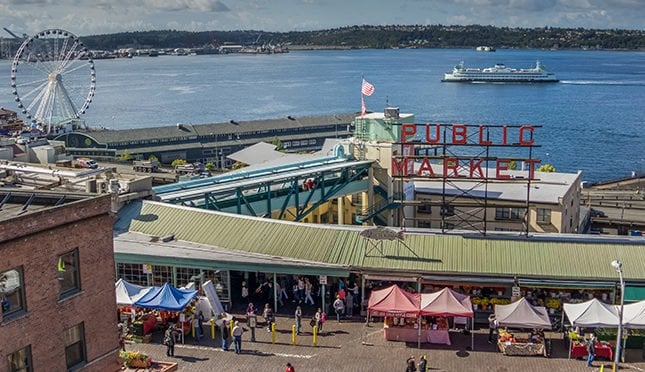Walk around Seattle on a clear day—there are more of them here than most people realize—and it is a wonderland. The Cascade Mountains are to the east with the 14,400-foot snowcapped Mount Rainier presiding, and the Olympic Mountains rise in the west, seemingly springing up out of the Pacific Ocean. The city is skirted by 200 miles of shoreline, with Puget Sound on one side and Lake Washington on the other.
There are many dimensions to this lush and undulating city of 725,000 people. It’s one of the most educated in the country—63 percent of residents age 25 and older had a four-year college degree as of 2017, compared to a national average of only around 33 percent. It is an enclave for artists, artisans, activists and innovators. Boeing, Microsoft and Starbucks paved the way for the city’s initial ascent as a global business hub. And over the last decade, as Amazon has thrived, Seattle has made its mark as a technology hub.
But some of Seattle’s best features are also the source of its growing pains. Rapid job growth has made it one of the fastest-growing American cities over the past decade, driving up housing prices and rents, and pushing people out to the far suburbs and, in extreme cases, onto the streets.
READ MORE: How to Serve on a Nonprofit Board
“When police officers, first responders and teachers have to move their families out of the cities they serve in, we have a problem,” says former Washington governor Christine Gregoire, who now runs Challenge Seattle, an alliance of 17 CEOs from the region’s largest employers that focuses on tackling civic issues. When Challenge Seattle started in 2015, one of its primary focuses was bringing more jobs to the region. Last summer, the group turned its attention to housing. Nobody “anticipated the day when we would have more jobs than places to live,” Gregoire says, “but that’s kind of the point we find ourselves at now.”
Most of the homeless people have been here for less than a year.
Yet Seattle has not brushed aside issues of homelessness and affordability. On January 1, the minimum wage in the city for companies with more than 500 employees globally rose to $16 per hour (smaller companies are required to pay slightly less—$15 per hour). And in January, Microsoft pledged $500 million to provide early-stage, low-interest loans to for-profit and nonprofit developers and government entities. The goal: to ignite broader efforts to mitigate the affordable housing crisis throughout the Seattle area. It is the most significant financial commitment to the community in Microsoft’s 44-year history and possibly the largest such commitment ever made by a company.
“I don’t know of any other program of this magnitude that addresses the need for housing and the problem of homelessness,” says Daniel Flaming, president of Economic Roundtable, a Los Angeles-based nonprofit urban research organization.
With Microsoft’s money as a catalyst, Seattle could lead the way on affordable housing, a huge challenge for cities nationwide. “With these and similar investments, it’s possible to lend money, accelerate progress, be repaid and then lend this money again,” Microsoft president Brad Smith and chief financial officer Amy Hood wrote in a company blog post. “While this is just one of the many ways that we’ll seek to put money to good use, it illustrates [that] our financial commitment can have a multiplier effect.”

When Gregoire first moved to Seattle in the 1960s to attend the University of Washington, most people around the country knew little about the city outside of its iconic Space Needle. “If you used the word Washington, it meant D.C.,” she says. Now, tourists amble through the stalls at Pike Place Market, pedal share bikes through the Olympic Sculpture Park and file through the Frank Gehry-designed Museum of Pop Culture, or MoPOP, to pay homage to Seattle natives Jimi Hendrix, Nirvana and Pearl Jam.
The last decade has brought particularly dramatic changes, and not just in and around the South Lake Union district where Amazon occupies roughly 12 million square feet of real estate. In Fremont, a neighborhood whose motto is De Libertas Quirkas (or Freedom to be Quirky, in sort-of Latin), one of Google’s Seattle campuses is less than 300 feet from the famous troll sculpture under the Aurora Bridge. Capitol Hill, a bastion of grunge music and gay culture, is home to micro-apartments and cycling studios.
READ MORE: The Simplest Solution to Fixing Wealth Inequality
